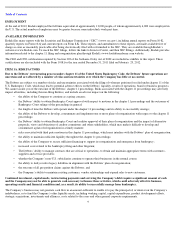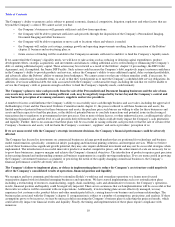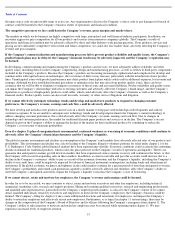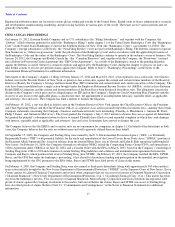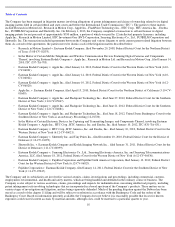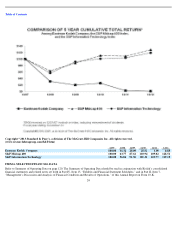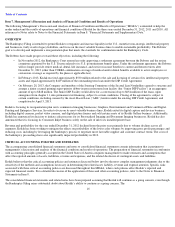Kodak 2012 Annual Report Download - page 20
Download and view the complete annual report
Please find page 20 of the 2012 Kodak annual report below. You can navigate through the pages in the report by either clicking on the pages listed below, or by using the keyword search tool below to find specific information within the annual report.
Table of Contents
Regional distribution centers are located in various places within and outside of the United States. Kodak owns or leases administrative, research
and development, manufacturing, marketing, and processing facilities in various parts of the world. The leases are for various periods and are
generally renewable.
ITEM 3. LEGAL PROCEEDINGS
On January 19, 2012, Eastman Kodak Company and its U.S. subsidiaries (the “Filing Subsidiaries,” and together with the Company, the
“Debtors”) filed voluntary petitions for relief (the “Bankruptcy Filing”) under chapter 11 of the United States Bankruptcy Code (the “
Bankruptcy
Code”) in the United States Bankruptcy Court for the Southern District of New York (the “Bankruptcy Court”) case number 12-10202. The
Company’s foreign subsidiaries (collectively, the “Non-Filing Entities”) were not part of the Bankruptcy Filing. The Debtors continue to operate
their businesses as “debtors-in-possession” under the jurisdiction of the Bankruptcy Court and in accordance with the applicable provisions of
the Bankruptcy Code and the orders of the Bankruptcy Court. The Non-Filing Entities continue to operate in the ordinary course of business. On
January 20, 2012, the Company and Kodak Canada Inc. (the “Canadian Borrower” and, together with the Company, the “Borrowers”) entered
into a Debtor-in-Possession Credit Agreement (the “DIP Credit Agreement”). As a result of the Bankruptcy, much of the pending litigation
against the Debtors is stayed. Subject to certain exceptions and approval by the Bankruptcy Court, during the chapter 11 process, no party can
take further actions to recover pre-petition claims against the Company. Refer to Note 1, “Bankruptcy Proceedings” in the Notes to the
Consolidated Financial Statements for additional information.
Subsequent to the Company’s chapter 11 filing, between January 27, 2012 and March 22, 2012, several putative class action suits were filed in
federal court in the Western District of New York, as putative class action suits, against the current and certain former members of the Board of
Directors (Board), the Company’
s Savings and Investment Plan (SIP) Committee and certain former and current executives of the Company. The
suits have been consolidated into a single action brought under the Employee Retirement Income Security Act (ERISA), styled as In re Eastman
Kodak ERISA Litigation, and the current and former members of the Board have been dismissed from those suits. The allegations concern the
decline in the Company’s stock price and its alleged impact on SIP and on the Company’s Employee Stock Ownership Plan. Plaintiffs seek the
recovery of any losses to the applicable plans, a constructive trust, the appointment of an independent fiduciary, equitable relief, as applicable,
and attorneys’ fees and costs. The Company has filed a motion to dismiss the litigation.
On February 10, 2012, a suit was filed in federal court in the Southern District of New York against the Chief Executive Officer, the President
and Chief Operating Officer and the Chief Financial Officer, as a putative class action suit under the federal securities laws, claiming that certain
Company statements concerning the Company’s business and financial results were misleading (Timothy A. Hutchinson v. Antonio M. Perez,
Philip J. Faraci, and Antoinette McCorvey). The Court granted the Company’s July 2, 2012 motion to dismiss this case as against all defendants
but granted the plaintiff’s subsequent motion for leave to amend. Plaintiffs have filed a second amended complaint in which they seek damages
with interest, equitable relief as applicable, and attorneys’ fees and costs. Defendants have moved to dismiss the case.
The Company believes that the ERISA and securities suits are not uncommon for companies in chapter 11. On behalf of the defendants in both
cases, the Company believes that the suits are without merit and will vigorously defend them on their behalf.
On September 15, 2003, the Company and Sterling Drug were named by the U.S. Environmental Protection Agency (“EPA”) as Potentially
Responsible Parties (“PRP”) with potential liability for the study and remediation of the Lower Passaic River Study Area (“LPRSA”) portion of
the Diamond Alkali Superfund Site, based on releases from the former Hilton Davis site in Newark and Lehn & Fink operations in Bloomfield,
New Jersey. On February 10, 2004, the Company (through its subsidiary NPEC) joined the Cooperating Parties Group (CPG) and entered into a
122(h) Agreement under CERCLA on June 22, 2004, and a Consent Order with the EPA on May 8, 2007, based on the Company’
s ownership of
Sterling Drug from 1988 to 1994 and retention of certain Sterling Drug liabilities and a defense and indemnification agreement between the
Company and Bayer, which purchased all stock in Sterling Drug (now STWB). On February 29, 2012, the Company notified the EPA, STWB,
Bayer, and the CPG that under the bankruptcy proceeding, it has elected to discontinue funding and participation in the remedial investigation
being implemented by the CPG pursuant to the EPA Order. Bayer and STWB have filed proofs of claim in this matter.
On February 4, 2009, the Company and Sterling Drug were also named as third-party defendants (along with approximately 300 other entities)
in an action initially brought by the New Jersey Department of Environmental Protection (“NJDEP”)
in the Supreme Court of New Jersey, Essex
County against Occidental Chemical Corporation and several other companies that are successors in interest to Diamond Shamrock Corporation
(“Diamond Shamrock”) (New Jersey Department of Environmental Protection, et al. v. Occidental Chemical Corp., et al.). This matter has been
stayed in the bankruptcy process. Two successors to Diamond Shamrock, Maxus Energy Corporation and Tierra Solutions Incorporated, filed
proofs of claims against the Company in relation to this matter, but later withdrew the claims. Bayer and STWB (successor to Sterling Drug)
have also filed proofs of claims. Refer to Note 13, “Commitments and Contingencies,” in the Notes to Financial Statements for additional
information.
17


